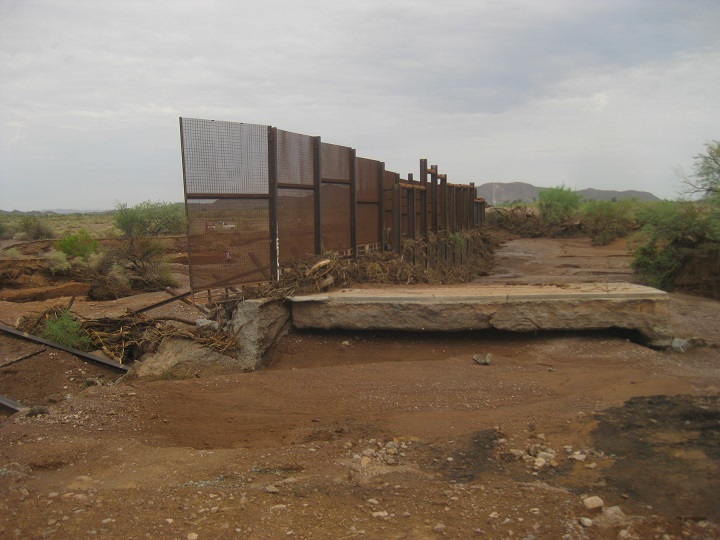As Director of Equity, Inclusion and Justice at Sierra Club, I often hear the question: why doesn’t Sierra Club stick to “environmental issues”? Today we’ll be turning over our blog to guest writer Susan Thomas, a volunteer on the Sierra Club Borderlands team, to talk about the deep connections between the natural environment and social issues, like immigration.
--Nellis
Donald Trump wants to build a wall—but he’ll face resistance from human rights groups, the environmental movement and Native activists every step of the way.
Most people don’t realize, but creating a physical barrier in the middle of a delicate desert ecosystem creates all kinds of environmental problems. As a volunteer on the Sierra Club Borderlands team, I’ve seen this firsthand, and learned that walls are the most expensive and least effective approach to border security, since they are easily and routinely scaled.
Sierra Club program organizer Dan Millis helps facilitate the Borderlands Team here in our hometown of Tucson. More than 650 miles of the U.S./Mexico border already have barriers and our team has been fighting the negative effects of those existing walls alongside coalition partners for more than a decade. We lead regular public tours on the border, give talks about the wall’s environmental and human costs, and educate journalists about border issues. Besides costing millions of dollars per mile to build and maintain - the Department of Homeland Security estimates $21.6 billion for Trump’s wall—walls also don’t address the root causes of complex border problems.
On the Borderlands team, we take every opportunity to lift up the perspective of Tohono O'odham Hemajkam Rights Network (TOHRN), which is fighting against an expansion of the border wall. The Tohono O’odham Nation’s 30,000 tribal members live on the second largest reservation in the United States, which includes 75 miles of the U.S./Mexico border. TOHRN is a tribal grassroots activist collective that helps to empower community members by raising awareness of rights and building strength through collectivity. TOHRN also works to addresses militarization and other threats to the health of O'odham territories, like environmental capitalism, trade development and colonial politics.
The existing fences have already divided O’odham families. According to Nellie Jo David, a member of the Tohono O’odham Nation and law student at the University of Arizona, “The barrier that is already there makes it difficult for those seeking medical services, visiting relatives, keeping ceremonial traditions, and commuting for basic life necessities.”
“Maintaining connections across boundaries is vital to who we are as people,” David said. “Many tribal members are concerned about what Trump’s expanded wall will mean for O’odham families on both sides.”
Another partner the Borderlands team works with closely, the Coalición de Derechos Humanos (Human Rights Coalition), is concerned about human rights abuses directed at migrants trying to cross the border. For a decade, the Coalición and the Sierra Club have worked together to oppose the militarization of the border. According to Isabel García, an attorney and Coalición spokesperson, more than 5,000 people have died while crossing the desert to seek safety and economic justice for their families. Migrants have been increasingly criminalized for over a decade, she says, a direct result of the U.S. immigration policy known as Operation Streamline. García believes that the American public has been made fearful and kept uninformed about border issues and history. “The Coalición is a part of a larger struggle,” she adds, “so we are working with environmental groups to fight the abuse to human beings, national monuments, and wildlife along the border.”
Some of the challenges posed by a border wall are more traditional environmental issues that one might expect Sierra Club to work on—like flooding and severe disruption of animal migration and habitats. Walls built of solid concrete, which already exist in South Texas along the Rio Grande River, isolate many kinds of wildlife from their primary water source and viable habitat. Endangered species, such as the ocelot and jaguarundi, are threatened by floods that cut off their escape routes. Even in dry climates like Arizona, where the border walls are built of closely spaced steel posts, they get clogged up with water and debris. In heavy summer rainstorms, sections of the walls sometimes collapse, sending water rushing into Nogales, Arizona, and Nogales, Sonora, and flooding border communities that already struggle with high levels of poverty.
Whether you’re concerned about human rights, tribal sovereignty or impacts on delicate ecosystems, we can all agree: our border communities should not be subject to hate, intolerance and xenophobia. That’s why we are working with our partner groups to demonstrate to lawmakers, and to the public, that what we need here are 21st-century solutions, not 5th-century technologies like border walls.
Susan Thomas, PhD, is a volunteer with the Sierra Club Borderlands team and lives in Tucson, Arizona. For more information, see sierraclub.org/borderlands or follow @SC_Borderlands on Twitter.
